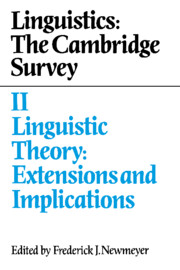Book contents
- Frontmatter
- Contents
- Contributors
- Preface
- 1 Extensions and implications of linguistic theory: an overview
- 2 Grammar and language processing
- 3 Grammatical principles of first language acquisition: theory and evidence
- 4 Second language acquisition and grammatical theory
- 5 Brain structures and linguistic capacity
- 6 Abnormal language acquisition and the modularity of language
- 7 Grammatical aspects of speech errors
- 8 Grammar and conversational principles
- 9 Discourse analysis: a part of the study of linguistic competence
- 10 Speech act distinctions in grammar
- 11 Computer applications of linguistic theory
- 12 Metrics and phonological theory
- 13 Grammatical theory and signed languages
- 14 The linguistic status of creole languages: two perspectives
- 14.I Creole languages and the bioprogram
- 14.II Are creoles a special type of language?
- 14.III A dialog concerning the linguistic status of creole languages
- Subject index
- Name index
- Contents of volumes I, III, and IV
13 - Grammatical theory and signed languages
Published online by Cambridge University Press: 08 February 2010
- Frontmatter
- Contents
- Contributors
- Preface
- 1 Extensions and implications of linguistic theory: an overview
- 2 Grammar and language processing
- 3 Grammatical principles of first language acquisition: theory and evidence
- 4 Second language acquisition and grammatical theory
- 5 Brain structures and linguistic capacity
- 6 Abnormal language acquisition and the modularity of language
- 7 Grammatical aspects of speech errors
- 8 Grammar and conversational principles
- 9 Discourse analysis: a part of the study of linguistic competence
- 10 Speech act distinctions in grammar
- 11 Computer applications of linguistic theory
- 12 Metrics and phonological theory
- 13 Grammatical theory and signed languages
- 14 The linguistic status of creole languages: two perspectives
- 14.I Creole languages and the bioprogram
- 14.II Are creoles a special type of language?
- 14.III A dialog concerning the linguistic status of creole languages
- Subject index
- Name index
- Contents of volumes I, III, and IV
Summary
Introduction
Speculation about signed languages is as old as theories about human language in general. In Plato's The Cratylus (368 BC), Socrates muses on the relationship between names and forms, and considers the case of those who are deaf and their manner of naming:
Socrates: And here I will ask you a question: suppose that we had no voice nor tongue, and wanted to indicate objects to one another, should we not, like the deaf and dumb, make signs with the hands, and head and the rest of the body?
Hermogenes: There would be no choice, Socrates.
Socrates: We should imitate the nature of the thing, the elevation of our hands to heaven would mean lightness and upwardness; downwardness would be expressed by letting them drop to the ground; if we were describing the running of a horse, or any other animal, we should make our bodies and their gestures as like as we could to them. (Jowett 1953)
Over the centuries, various hypotheses have been put forward about signed languages and how they compare to oral languages. Many, like Plato, have been struck by the unique form of signed languages; lacking the familiar elements of speech and relying on the mode typically used for gesture, the overriding impression of signs is that they are largely analogic and have little segmentable content. Socrates warns Hermogenes that ‘imitation’ such as vocal mimicking of animals and the like cannot be considered ‘naming’, but he leaves open the question of whether the gestures of the ‘deaf and dumb’ are imitative or linguistic.
- Type
- Chapter
- Information
- Linguistics: The Cambridge Survey , pp. 250 - 266Publisher: Cambridge University PressPrint publication year: 1988
- 9
- Cited by

